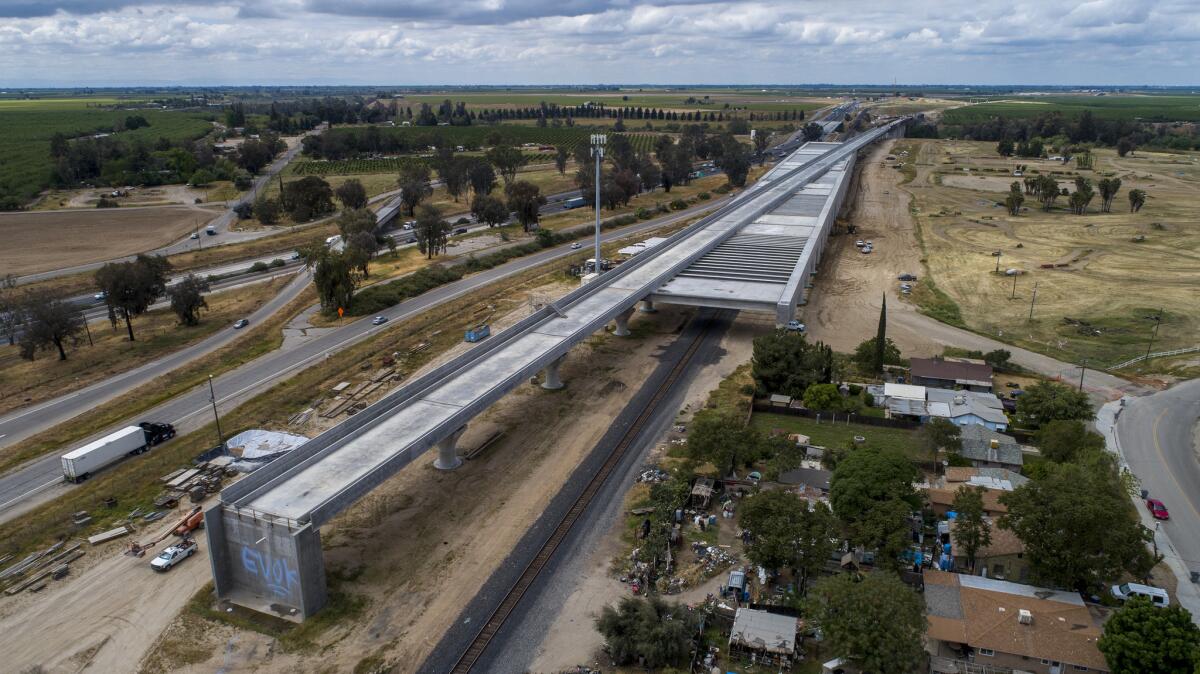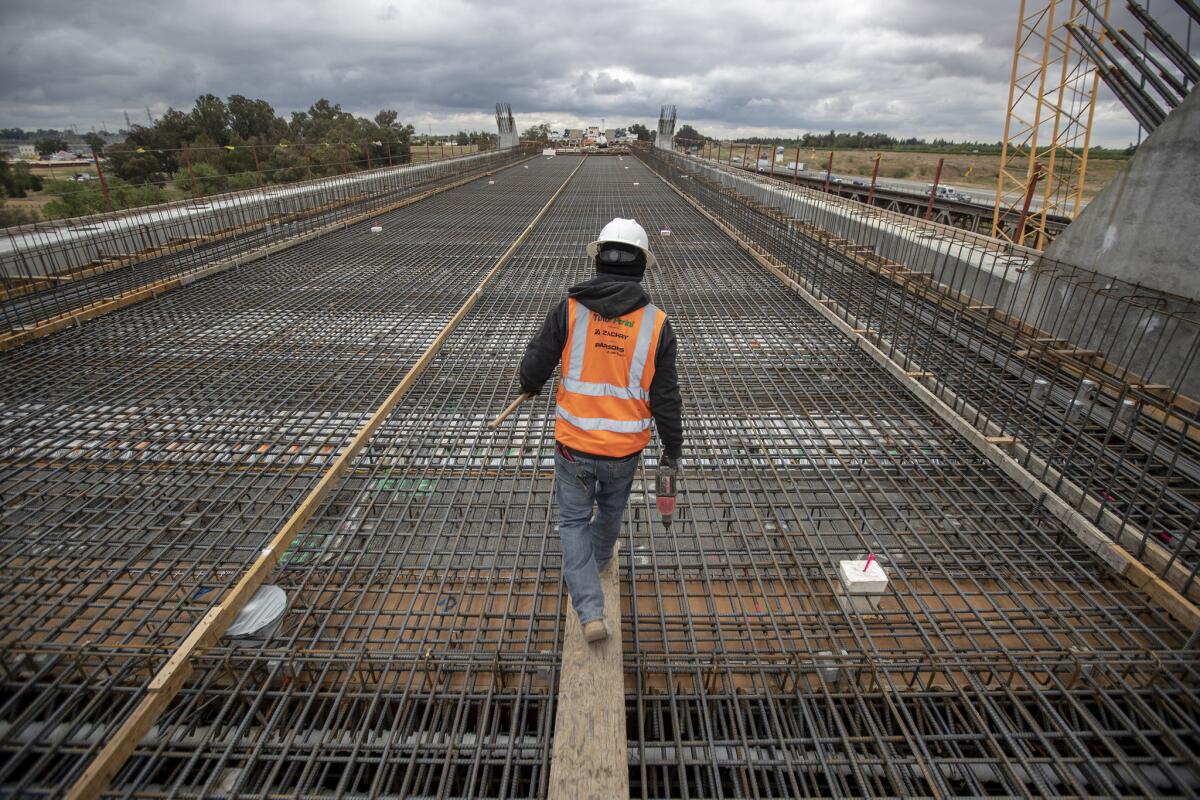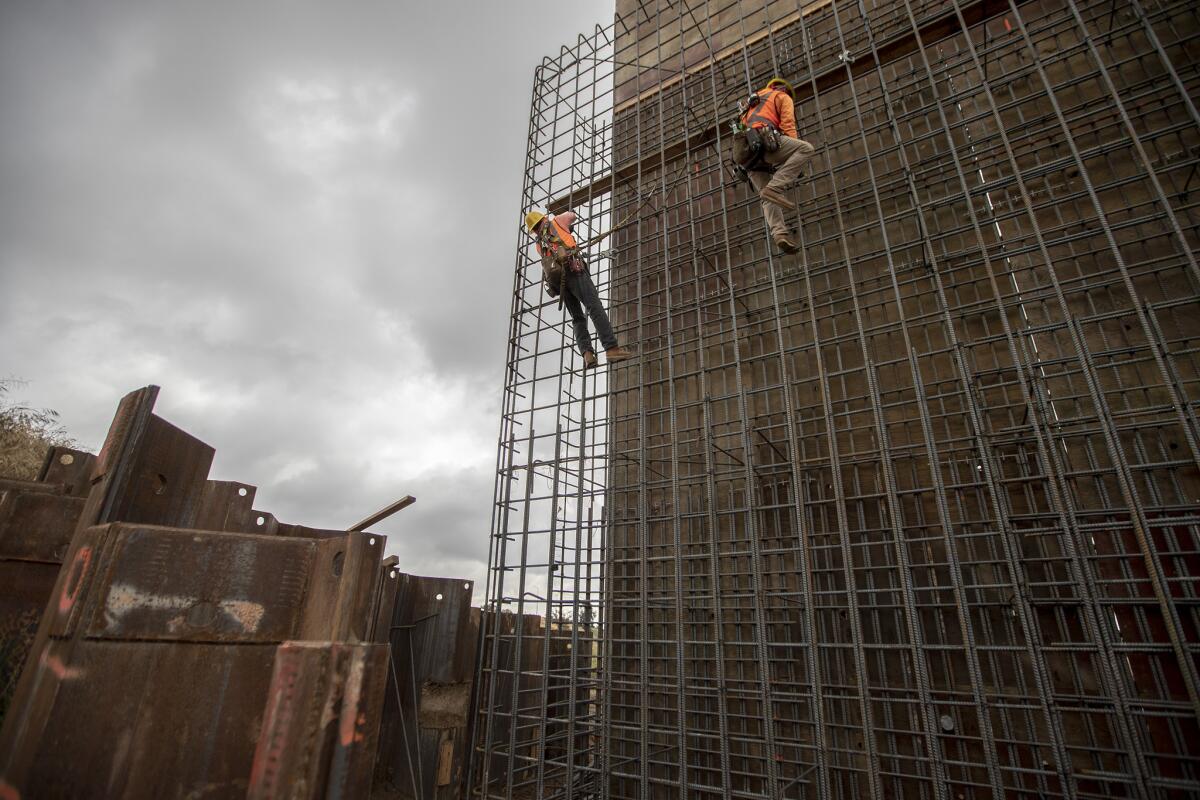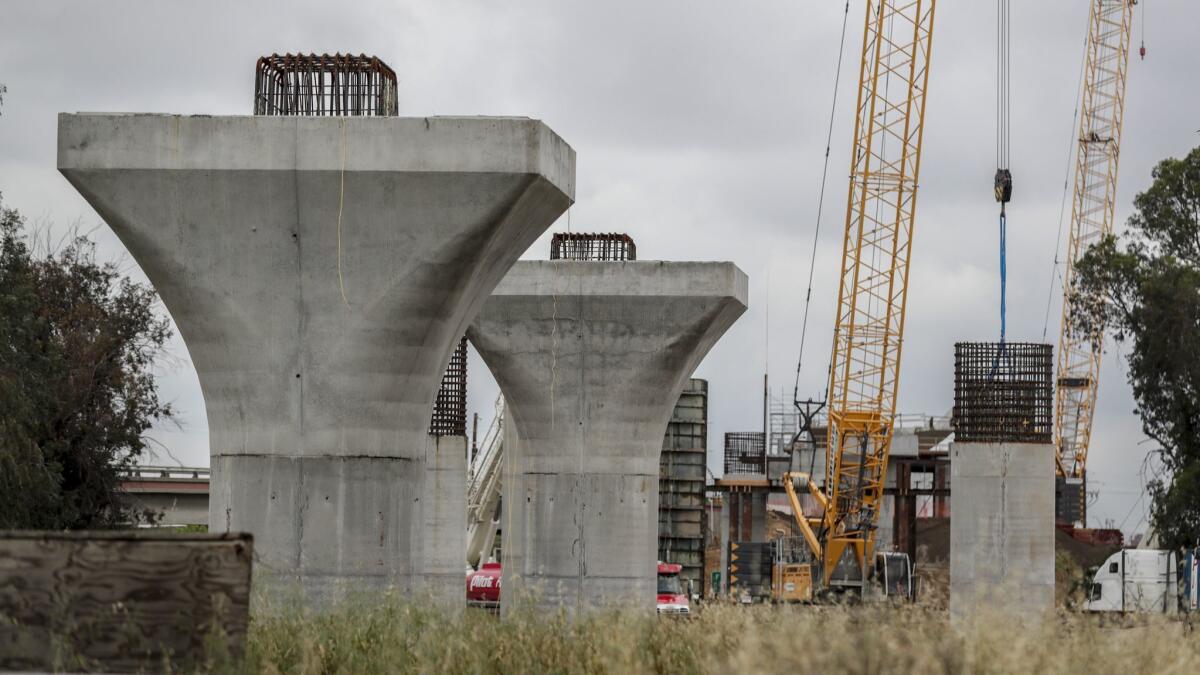How California’s faltering high-speed rail project was ‘captured’ by costly consultants

- Share via
When California shifted its bullet train plan into high gear in 2008, it had just 10 employees to manage and oversee design of the largest public construction project in state history.
Consultants assured the state there was little reason to hire hundreds or thousands of in-house engineers and rail experts, because the consultants could handle the heavy work themselves and save California money. It would take them only 12 years to bore under mountains, bridge rivers and build 520 miles of rail bed — all at a cost of just $33 billion.
State officials followed that advice, and for the next several years, development of the nation’s first high-speed rail line was overseen by a minuscule government staff.
Now, more than a decade later, that decision has proved to be a foundational error in the project’s execution — a miscalculation that has resulted in the California High-Speed Rail Authority being overly reliant on a network of high-cost consultants who have consistently underestimated the difficulty of the task.
Today, these consultants manage nearly every aspect of the job: They direct day-to-day construction work in the Central Valley and negotiate with farmers to buy land. They assess the geological conditions in the San Gabriel Mountains and estimate how many people will ride the future system. They produce tens of thousands of pages of reports and attend community meetings. They even oversee other consultants.
But significant portions of this work have been flawed or mismanaged, according to records reviewed by The Times and interviews with dozens of people involved in the project. Despite repeated warnings since 2010 about weaknesses in its staffing, the rail authority believed it could reduce overall costs by relying on consultants and avoiding a large permanent workforce. But that strategy has failed to keep project costs from soaring. Ten years after voters approved it, the project is $44 billion over budget and 13 years behind schedule.
A reckoning may be coming very soon, however.
Gov. Gavin Newsom recently told The Times that he would be taking aim at the consultants when the rail authority sends a major project update to the Legislature on May 1, including a detailed plan on building a partial operating system from Bakersfield to Merced for $16 billion to $18 billion.

“I’m getting rid of a lot of consultants,” Newsom said. “How did we get away with this?”
But actually reducing the role of consultants will be problematic because they have become cemented into place.
When state rail authority employees go to their Sacramento headquarters, they work in offices rented by a consultant. When they turn on their computers, much of their data is stored on servers owned by consultants. The software they use to help manage the project is the property of a consultant.
The rail authority’s consultants are hardly household names, but they are politically powerful and made major contributions to support the 2008 political campaign for the bullet train bond. They have staffed their ranks with former high-level bureaucrats, and their former executives have occupied key government posts.
They include such firms as WSP, Project Finance Advisory, Cambridge Systematics, Arup, T.Y. Lin, HNTB, PGH Wong Engineering, Harris & Associates, Arcadis, STV, Sener Engineering and Systems, Parsons Transportation and many others.
To be sure, consultants are a routine part of many state construction projects. In California, however, high-speed rail is in a league of its own when it comes to reliance on outside staffing.
Experts in high-speed rail and mega-projects in general say it is crucial to have a balance between outside help and a strong government staff that can make independent judgments about the advice it is getting.
“If you depend on consultants to know what you are doing, then you are in real trouble,” said Bent Flyvbjerg, an Oxford University professor who has studied high-speed rail projects around the world. “A good balance is where the owner is not outsourcing all the knowledge. A bad balance guarantees a bad outcome.”
Brian Kelly, chief executive of the rail authority, acknowledges that “the balance needs to be remedied.”
The consultants, he said, share in the responsibility for the problems, but “it is the [rail] authority that brought in the consultants and is ultimately responsible to the public.”
WSP, a Montreal-based international engineering firm, leads the state’s main consulting operation, Rail Delivery Partner.

Formerly known as Parsons Brinckerhoff, WSP has been involved in many giant engineering works, some of which won awards and others that went far over budget and past deadline, including Boston’s troubled Big Dig, the Honolulu light rail project and a transit system in St. Louis.
It is WSP that holds the lease on much of the office space at rail authority headquarters, supplies proprietary software that the authority uses and provides servers that store the project’s data. The firm also helps oversee three other consulting ventures that monitor construction teams — Wong-Harris for the Fresno area, Arcadis for Kings County and HNTB for Tulare County. (Each of those three consultants have teams of subconsultants who work under them.)
In 2008, WSP developed the estimate that the Los Angeles-to-San Francisco line would cost $33 billion and take 12 years to build. In the same year, voters approved a $9-billion bond that was supposed to fund one-third of the project.
“We listened to their estimates,” said Quentin Kopp, who was chairman of the rail board in 2008 but has since become an ardent critic. “They were clearly wrong.”
Given the enormity of building a 520-mile rail system, the 10-member rail authority team that existed in the early years amounted to a “cheer squad,” Kopp said.
WSP has stayed on the job for about a quarter of a century. It was given a new $700-million contract in 2015, despite warning signs that the project was headed for major cost overruns and had encountered serious delays.
Gregory Kelly, CEO of WSP USA, a New York City-based unit of the firm, defends the company’s role in the project and says it brings world-class engineering, project management and environmental know-how that the state could not possibly duplicate. It would be “wildly inefficient for the state to staff up” to replace the role of consultants, he said in an interview in Los Angeles.
As for the problems, Kelly acknowledges some responsibility. “I am not here to say the client was wrong and we have no involvement,” Kelly said. “We are all part of the team.”
Kelly said he wants a “realignment” of duties between the consultants and the state staff.
WSP alone has about 470 employees on the project, and many hundreds of other consultants are spread out at offices across Sacramento, Fresno and San Francisco.
By comparison, the rail authority now has 180 employees, but it has more than 40 vacant positions and is actually smaller than a year ago, according to a March financial report. Kelly, the rail authority CEO, said the vacancy rate is higher than he would like.
“Candidly, we have some difficulty bringing people in when it is unclear what the future of the project is,” he said. “That’s a real challenge we have to deal with.”
Other state agencies that build infrastructure and manage technical regulations employ far more staffers. The California Department of Transportation alone said it has a staff of more than 7,000 engineers. The Department of Water Resources, which builds and maintains dams, said it has 1,519 engineers, scientists and technicians on its staff. The Air Resources Board has nearly 1,000.
Professional Engineers in California Government, a union that has 13,000 engineers at state agencies, has long argued that the rail authority is making a grave error by relying so heavily on outside consultants.
“They became a consultant-captured organization,” said Ted Toppin, executive director of the union. “This is an entity run entirely by engineering consultants for engineering consultants.”
Toppin provided state budget documents from 2010 that showed the rail authority’s contracts with consultants averaged $427,000 per engineer, compared with the rail authority’s state in-house costs of $131,000 per engineer. The counterargument made by consultants is that those numbers do not reflect differences in efficiency or quality of work.
State Auditor Elaine Howle released a scathing assessment of the project in November, citing the role of consultants 81 times. Consultants, the audit said, “may not always have the state’s best interests as their primary motivation.”
Howle and others say it hasn’t helped matters that the rail authority still relies on consultants to manage and oversee other consultants — an arrangement that has resulted in the appearance of a conflict of interest in at least one case and poor oversight of project work in general.
The rail authority, she said, has become dependent on WSP staff to fill jobs in its contract management and support offices, which have “performed only weak and inconsistent oversight” of the project work.
The audit examined nine sample contracts and found “significant problems” in reviewing invoices and documenting that work had actually been completed. In one example, the rail authority staffed a new office intended to improve contract management with seven consultants.
WSP executives said it was a “stretch” to allege that any problems they caused were responsible for billions of dollars in cost increases.

Several rail authority employees said in interviews that the audit correctly identified the confused relationship between state employees and consultants. In some cases, they said, state employees report to consultants, rather than the other way around.
“The underlying problem is that you have an organization that is broken,” said one manager at the rail authority who was not authorized to talk to the news media and requested anonymity. “You have managers brought in as promotions by their friends. They haven’t defined who does what.”
In some instances, the consultants have provided flawed advice, as well.
At one time, Cambridge Systematics, the consultant that developed ridership models, estimated that more than 90 million people would ride the trains every year, based on an overly optimistic assumption that 90% of motorists along the route would switch to trains, said David Brownstone, a UC Irvine economics professor who reviewed the work of consultants that provided ridership estimates.
“Once we pointed out all the problems, they lowered it to 25 million and characterized it as a minor change,” he said. “Calling that a minor adjustment was a flat-out lie. The mistakes were obvious and crude.”
In Brownstone’s opinion, the rail authority didn’t question the calculations because high ridership estimates supported its revenue projections.
“Some of these consultants will tell you whatever you want to hear for a fee,” Brownstone said.
Cambridge Systematics declined to comment.
It is also the consultants who write the project’s environmental impact statements and reports, among the most voluminous undertakings in the history of environmental regulation in California. The body of work includes dozens of reports covering 11 geographic sectors, nine years of business plans and numerous ridership studies.
A Times data analysis of the reports completed so far, involving more than 3,000 environmental statements, business documents and other reports, found they contained 152,000 pages that consultants largely generated. The Times could not locate anybody who claimed to have read all of the documents.
The consultants, however, have played a key role in the political success of the project. Along with labor unions, consultants helped fund the campaign for the $9-billion bond that is paying everybody’s salaries, including their own.
Engineering and construction firms contributed $837,000 to the bond campaign, second only to the $1.6 million spent by various unions, according to a Times review of campaign filings. WSP put $107,000 into the campaign. There was no organized opposition to the bond measure. It passed with 52.7% support, but its popularity has dropped in public opinion polls ever since.
The consultants continue to provide political muscle for the project. A revolving door provides lucrative job opportunities for state and federal officials to enter higher-paying private jobs.
The rail authority in May 2012 hired as its chief executive Jeff Morales, who had worked at WSP since 2004. Morales took a hiatus from WSP to work on President Obama’s transition team for the Department of Transportation, giving him key access to the administration’s future rail policies.
At the time he was hired by the rail authority, some legislators were worried about the potential conflicts of interest that Morales could bring, but rail authority Chairman Dan Richard said his board was “deeply impressed by his extensive experience in large and complex transportation issues and projects.”
Data Editor Ben Welsh contributed to this report.
More to Read
Sign up for Essential California
The most important California stories and recommendations in your inbox every morning.
You may occasionally receive promotional content from the Los Angeles Times.










